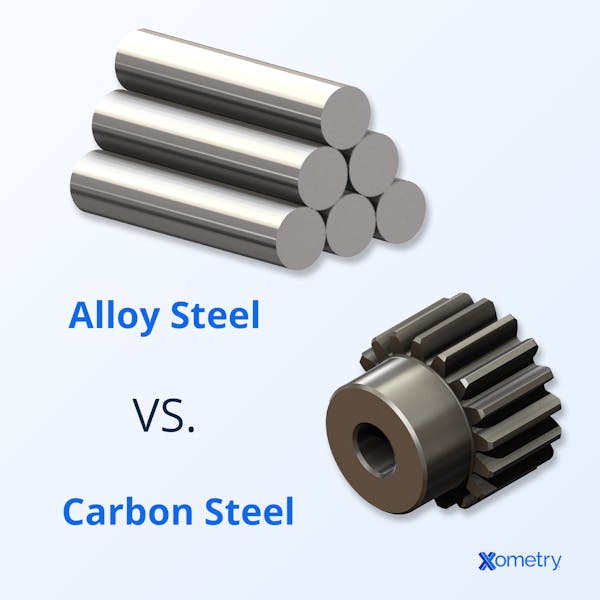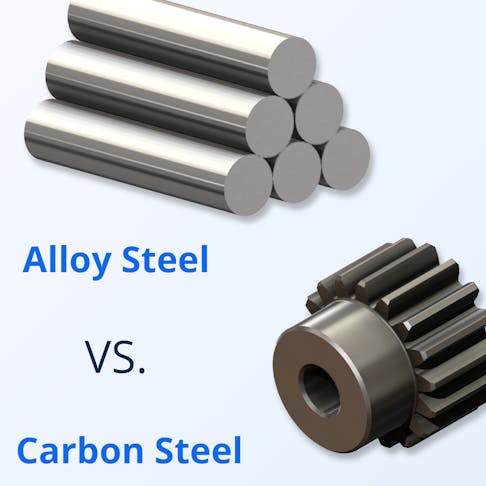There’s no denying that both alloy steel and carbon steel are extremely useful metals and are very popular among Xometry customers from a wide range of industries, but they’re so similar that it can be hard to know the difference so you can choose between them. They’re both strong, hard, and durable, and can be heat-treated to improve these factors. They’re both mainly made up of iron, with small amounts of other elements like carbon, chromium, molybdenum, manganese, and nickel. As if that’s not confusing enough, they can both be made in many different grades that each has its own set of unique benefits.
With all these similarities you could be inclined to believe that these metals are interchangeable, but you’d have to think again. There are some important differences that make them more or less suitable than the other in certain applications. We explain more about each of these steels further down and have even prepared a table that pits alloy steel and carbon steel against each other to see how they fare.
What is Alloy Steel?
Alloy steel has carbon along with other alloying elements in it, like aluminum, chromium, copper, manganese, nickel, silicon, or titanium. These other elements lend their strengths to the alloy steel, be it hardness, corrosion resistance, or durability. It’s suitable for high-temperature applications and is a common material in construction, automotive, aerospace, petrochemical, and power plants. Just a few of the parts it’s used for are gears, shafts, and axles.
Although there are many different steel alloy types, these generally fall into two categories: low-alloy steel and high-alloy steel. Low-alloy types are the most commonly used, popular in construction for pipes and beams. These are the alloys that will have carbon, manganese, silicon, copper, molybdenum, and/or nickel. They are ductile, but a bit weaker than other types.
High-alloy steel types have more than 5% of other elements (like chromium, vanadium, or tungsten) in them, which makes them extra strong and hard. They’re used for car and machinery parts, and in sectors like power generation, and chemical processing.
There’s also another one worth mentioning — tool steel. Used to make tools, this has a high carbon content and goodies like chromium, manganese, and tungsten to give it even more hardness and durability. Xometry offers auto-quoting for CNC machined parts in tool steel grades O1 and A2, among other alloy steels.

What is Carbon Steel?
Carbon steel is a metal made from iron with up to 2% carbon in it. It’s already strong and hard, but to make it even harder via heat treating processes. It’s used to make various machines and their parts, tools, bridges, car parts, and construction materials. One of the great things about it is that it can be used with various manufacturing methods, including the ones Xometry offers, like CNC machining, sheet cutting, sheet metal fabrication, and welding. Carbon steel types fall into four different categories depending on the amount of carbon in them:
- Low (aka “mild steel”): up to 0.30% carbon
- Medium: from 0.31% to 0.60%
- High: from 0.61% to 1.50%
- Ultra: up to 2%

| Property ↓ | Alloy Steel | Carbon Steel | Winner |
|---|---|---|---|
Property ↓ Thermal conductivity | Alloy Steel Good - 40-60 W/(mK) | Carbon Steel High - 45 W/(mK) | Winner Carbon |
Property ↓ Strength | Alloy Steel High | Carbon Steel Good | Winner Alloy |
Property ↓ Toughness | Alloy Steel High | Carbon Steel Good | Winner Alloy |
Property ↓ Tensile strength | Alloy Steel High - up to 960 MPa | Carbon Steel Good - Up to 450 MPa | Winner Alloy |
Property ↓ Ductility | Alloy Steel Good | Carbon Steel Fair | Winner Alloy |
Property ↓ Wear and tear resistance | Alloy Steel High | Carbon Steel Fair | Winner Alloy |
Property ↓ Corrosion resistance | Alloy Steel High (depending on alloying elements) | Carbon Steel Low (if not coated) | Winner Alloy |
Property ↓ Weldability | Alloy Steel Good | Carbon Steel High | Winner Carbon |
Property ↓ Machinability | Alloy Steel Fair to good (depending on alloying elements) | Carbon Steel Good to excellent (in low-carbon types) | Winner Carbon |
Property ↓ Magnetism | Alloy Steel Usually magnetic | Carbon Steel Magnetic (depending on carbon content) | Winner Depends on use |
Property ↓ Heat resistance | Alloy Steel High (depending on alloying elements) | Carbon Steel Fair (depending on carbon content) | Winner Alloy |
Property ↓ Melting point | Alloy Steel 1,400–1,500°C | Carbon Steel 1,425–1,530°C | Winner Both |
Property ↓ Heat treatable | Alloy Steel Yes | Carbon Steel Yes | Winner Both |
Property ↓ Cost | Alloy Steel High | Carbon Steel Fair | Winner Carbon |
Alloy Steel vs. Carbon Steel Properties
What Are the Types of Alloy Steel?
There are many different types of alloy steel, each with unique properties and applications. Several broad categories are listed below:
- Low-alloy steel: These steels are the most common and incorporate carbon, manganese, silicon, copper, nickel, and/or molybdenum. Low-alloy steels are typically weaker and more ductile than others. They are widely used in the construction industry in the form of pipes and beams.
- High-alloy steel: High-alloy steel contains more than 5% of another element such as chromium, vanadium, or tungsten. These steels are incredibly strong and hard, making them ideal for use in automotive construction, power generation, and chemical processing equipment.
- Tool steel: Tool steel is a type of alloy steel that is particularly well-suited for making tools. It contains a high proportion of carbon as well as other elements such as chromium, manganese, and/or tungsten. Tool steels are incredibly hard and durable, making them ideal for use in cutting and drilling tools.
What Are the Types of Carbon Steel?
Different types of carbon steel are classified based on the amount of carbon present in the alloy. Below are the categories of carbon steel:
- Low-carbon steel (or mild steel): (also known as mild steel) Contains up to 0.30% carbon.
- Medium-carbon steel: Contains between 0.31% and 0.60% carbon.
- High-carbon steel: Contains between 0.61% and 1.50% carbon.
- Ultra-high-carbon steel: Contains between 1.51% and 2% carbon.
What Are the Advantages of Alloy Steel Compared to Carbon Steel?
Listed below are the advantages of alloy steel compared to carbon steel:
- Alloy steels are more resistant to wear and tear than carbon steel
- Alloy steels are more resistant to corrosion and can be used in high-temperature environments without fear of damage.
- Alloy steels can be heat-treated to increase their strength and hardness, making them even more durable.
- Alloy steels are generally stronger and tougher than carbon steels.
What Are the Disadvantages of Alloy Steel Compared to Carbon Steel?
Listed below are the disadvantages of alloy steel compared to carbon steel:
- Alloy steels are more expensive to produce than carbon steels.
- Alloy steels are more difficult to weld than carbon steels.
- Alloy steels are more susceptible to corrosion than carbon steels.
- Alloy steels have lower hardness and strength compared to carbon steels.
- Carbon steels can be more easily machined than alloy steels.
What Are the Comparisons Between Alloy Steel and Carbon Steel?
Table 3 highlights the comparisons between alloy steel and carbon steel:
| Alloy Steel | Carbon Steel | |
|---|---|---|
Thermal Conductivity | Alloy Steel Alloy steels vary in thermal conductivity but are generally less conductive than carbon steels | Carbon Steel Carbon steels have a higher thermal conductivity of about 45 W/(mK) |
Tensile Strength | Alloy Steel Alloy steels have higher tensile strength than carbon steels (up to 960 MPa) | Carbon Steel Carbon steels have lower tensile strength (450 MPa) |
Applications | Alloy Steel Used in a variety of high-temperature applications, such as in petrochemical and power plants | Carbon Steel Used in applications without particularly high temperatures |
Comparisons Between Alloy Steel and Carbon Steel
What Are the Mutual Alternatives to Alloy Steel and Carbon Steel?
Below are some mutual alternatives to both alloy and carbon steel:
- Stainless Steel: Like both alloy and carbon steel, stainless steel does not readily corrode, rust, or stain with water. Stainless steel is an alloy involving carbon and chromium.
- Nickel Alloys: Nickel alloys contain steel and nickel to make them resistant to corrosion and oxidation. They can also handle high temperatures, making them ideal for use in power plants and chemical plants.
What Are the Similarities Between Alloy Steel and Carbon Steel?
Alloy steels and carbon steels are both composed primarily of iron. They also contain small amounts of other elements, such as: carbon, manganese, chromium, molybdenum, and nickel. Both types can also be produced in a wide variety of grades, each with its own unique set of properties and characteristics. Both alloy steel and carbon steel are strong, hard, and durable. They can be heat-treated to increase their strength and hardness.
What Are the Other Comparisons for Carbon Steel Besides Alloy Steel?
Listed below are some other materials that, depending on the application, may serve as stand-ins for carbon steel:
- Cast Iron: This metal is made by re-melting pig iron, usually with considerable quantities of scrap iron and sometimes with steel. It is generally used for making gray iron castings.
- Ductile Iron: Also called nodular cast iron, spheroidal graphite iron, or nodular iron, this is a variation of cast iron that has been treated with an element such as cerium or magnesium while molten. The process is done to induce the formation of free graphite as nodules in the metal matrix.
- Wrought Iron: This is an iron alloy with very low carbon content. It is a semi-fused mass of iron with fibrous slag additions (up to 2% by weight), which gives it a "grain" resembling wood that is visible when it is etched or bent to the point of failure.
- Beryllium Copper Alloy: This copper alloy contains 0.5-3% beryllium and sometimes other elements. Beryllium copper combines high strength with non-magnetic and non-sparking qualities.
- Aluminum Bronze: This is an alloy of copper with aluminum in varying proportions. Typical compositions are 8–12% Al, 0.5–3% Fe, and 89–91% Cu. It is strong and corrosion-resistant, finding use in marine applications.
- Brass: The proportions of zinc and copper in this alloy can be varied to reach different mechanical and electrical properties.
What Are the Other Comparisons for Alloy Steel Besides Carbon Steel?
Listed below are a few other alternatives to alloy steel:
- Chrome Steel: A chrome Steel is created by plating a layer of chromium on carbon steel. It is highly corrosion-resistant and is used for applications that include: drills, tools, and utensils.
- Copper Steel: An alloy of copper and steel used in the manufacture of rail tank cars and bridges.
- Beryllium Steel: This alloy of beryllium and iron regularly appears in the aerospace industry for its high strength and low weight.
- Aluminum Steel: Aluminum can be alloyed with other metals to give it superior properties. Aluminum alloys include the 3003 aluminum alloy and the 3004 aluminum alloy. They are used in the production of cooking utensils, pressure vessels, beverage cans, and sheet metal fabrications.
- Magnesium Steel: An alloy of magnesium and steel, this material gets used in the automotive industry for its low density and high strength.
- Tungsten Steel: An alloy of tungsten and steel is regularly used in the manufacture of cutting tools and other wear-resistant parts.
How Xometry Can Help
We hope this article was helpful in explaining the differences between alloy steel and carbon steel, and that you’ve managed to decide which one is best for your manufacturing needs. If neither sounds appealing, fret not! Stainless steel or nickel alloys can replace them both. Xometry offers many different services using these metals, including CNC machining, sheet cutting, sheet metal fabrication, and much more! You can easily get your free quote here, or for more information on any of these materials or our services, please feel free to reach out to one of our reps.
Disclaimer
The content appearing on this webpage is for informational purposes only. Xometry makes no representation or warranty of any kind, be it expressed or implied, as to the accuracy, completeness, or validity of the information. Any performance parameters, geometric tolerances, specific design features, quality and types of materials, or processes should not be inferred to represent what will be delivered by third-party suppliers or manufacturers through Xometry’s network. Buyers seeking quotes for parts are responsible for defining the specific requirements for those parts. Please refer to our terms and conditions for more information.

